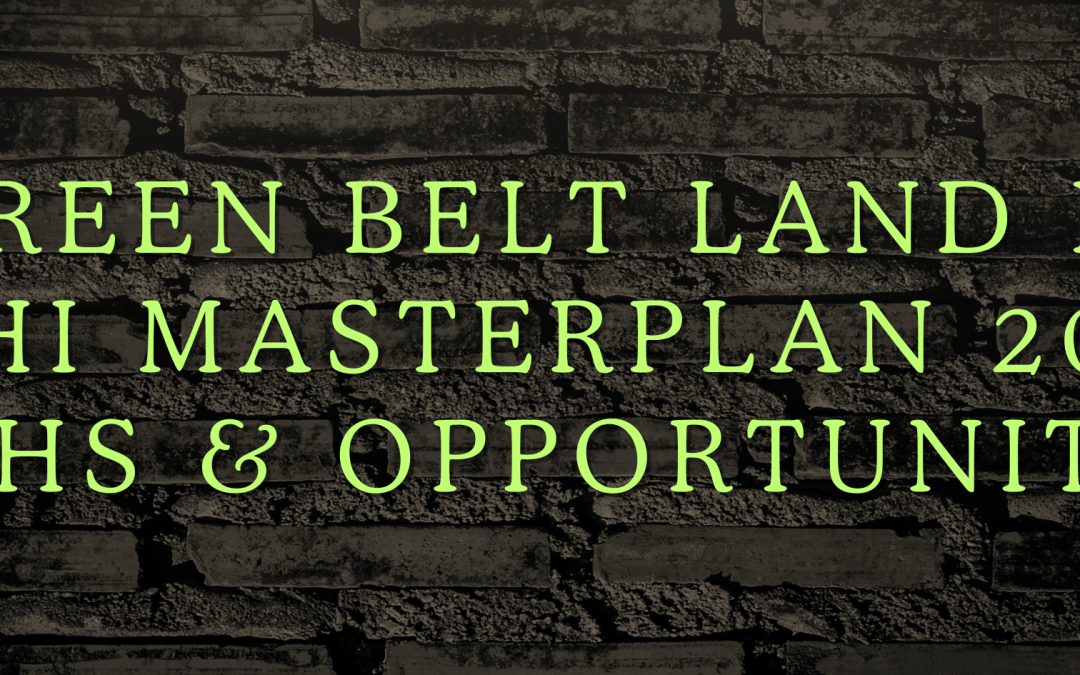Delhi is amongst the greenest cities in the country, if not the most, amongst the metros. Under the Masterplan of 2001, almost 8722 Ha of land, OR, close to 19% of the land area is covered under Green/Recreational use. The Ridge on the Northern, Central & southern areas constitute almost 1577 Ha. That is not all. About 7145 Ha is in the form of City & District level parks, community parks etc, which comprise almost 15% of the total Urban land. Within the approved urbanized areas, large tracts of land are left under the neighborhood parks, plantations, nurseries etc, within the residential areas. Let us also not forget the large institutions & campuses in Delhi like the Delhi University, JNU campus, President’s estate, various forest lands & green areas around canals & drains, IARI – Pusa & other research campuses within Delhi, which are green(er). Not to ignore the bio-diversity parks under development by the Delhi government.
The reason to appraise the readers of the above statistics is to talk about the great potential for organized green belt development under Delhi, and the many pitfalls that are faced by the buyers.
I suffer great consternation when I am confronted with the many a half-truths and assumptions about the Green belt land, and its purported admissions, regulations & development. The basic myth or wrongful assumption being – “any Agricultural land is Green belt land”.
I thought it pertinent to bring to fore the facts, and explore jointly, the opportunities for the citizen investors, rather than the institutional & developers only.
Myth # 01 – Any Village land is green belt land
A big thumbs down to this assumption. “The MPD 2021 Plan stipulates that the land upto the depth of one peripheral village revenue boundary along the border of NCTD, wherever available, would be maintained as Green Belt”. (Ref. Clause 3.2.1 of notification of MPD). It also doesn’t mean that every last peripheral village of Delhi is classified as green. To take an objective view of the same, one has to refer to the notified zonal plans, under each zone, and further understand the location of the land on the village revenue records (shijra / Khatauni). I have come across many investors who have gone by hearsay, rather than research & expert advice, in buying land, for use as a farmhouse, under the green belt lands.
Myth # 02 – No permissions are required for Green belt development
Let the readers be informed that permissions are required for the development of any land parcel, for any land use, and for any category of development, from the empowered authorities. In the case of Delhi green belt lands, besides the DDA, MCD and other agencies, there are no objection certificates (NOC) too to be obtained from the local offices of the Land & revenue department. Caution should be exercised while following advice from sources with limited knowledge.
Myth # 03 – Registry & mutation would ensure that land isn’t acquired ever
Without getting into the absolute technical grounds, be informed that within Delhi, there are lands which are governed by separate set of rules, for e.g: Punjab Land act, Delhi land act, MCD act etc. etc. Though many such land parcels fall into the “Green zone” shown on the notified map/ Zoning of MPD 2021, they necessarily DON’T signify automatic qualification of the said land parcels for development of Farmhouses.
Registry & mutation, signifying ownership doesn’t mean that the said land can’t be acquired for any other purpose, other than your own dwelling units. Let’s not forget that the government can acquire land parcels, at any time, for any purpose as deemed fit. The demographic explosion, coupled with the development of projects in the Green belt, also requires infrastructure, be it power, sewerage, social infrastructure, water, drainage etc. If not researched, and referred to expert groups on the master planning, significant down valuation would be suffered on green belt lands purchased. EXERCISE CAUTION.
Having said the above, there rests a HUGE OPPORTUNITY for all categories of investors, developers, HNIs and retail investors. Let me state some proven facts, as experienced both during research & transactions, by yours’ truly.
- Land returns the highest ROI amongst realty products
- If bought at the right time, it rarely devalues
- It is an asset, which you take possession of from day One.
- It has the most ‘flexible’ investment options
- Cost of managing your land Asset is negligible
- It is a highly liquid asset, with easy exit mechanism
- It privides the “right balance” in your real estate portfolio
THE GREEN BELT OPPORTUNITY IN DELHI
Now, why should the HNIs & retail investors invest into Green belt lands in Delhi? Why should they direct their investment from residential & commercial developments, into Land? What to expect from the investments int Delhi Farmlands? Some reasons herewith listed:
Pent up Demand & demographics – The foremost reason being the demand scenario in Delhi, which would possibly be the highest captive pent up demand of almost 2.3 million Dwelling units. On the farmhouse front, one particular research by Delhifarms.com pegs the forecasted demand by 2015 at 15000 new Farm houses, on a ticket size of almost a million dollars apiece. This entire demand has to be fulfilled under the Green belt of Delhi under MPD 2021.
Supply is NOT A CONSTRAINT – As per the MPD 2021 & zonal plans released in 2010, there is an imminent supply of more than 11, 000 hectares of land which is being released, under the Green belt of Delhi. These green belt lands not only act as the lung space of Delhi, but also encourage the development of low-density dwellings within the boundaries of NCT Delhi, more particularly the farm houses.
Investment Infrastructure & interest
“Dilli tho Dilli hi rahega” is the common refrain that I get to hear, while transacting land deals in the other cities of NCR. Besides Farm houses, there are a lot of commercial interest activities which would be pursued within the Green belt of Delhi.
Table 9.4 of the notified Delhi master plan MPD 2021 document lists the following products / services / permitted activities which can be conducted within the Green belt areas of Delhi.
- Forest, Agriculture use, Vegetation belt, Dairy Farms, Piggery, Poultry farms, Farm house, Wildlife sanctuary, Bird sanctuary, Biodiversity Park, Veterinary Centre, Police Post, Fire Post, Smriti Van, Plant Nursery, Orchard, Area for water-harvesting, Floriculture farm, Open Playground, Agroforestry, Amenity structures
Sports & sports related infrastructure have now been included as part of the social infrastructure, which would kick start the initiatives by the private enterprise into this domain, more specifically under the Green Belt of Delhi. Progressively, Delhi is emerging as a venue for International events, and facilities created jointly, severally or under the PPP mode would be the way forward to integrate the logistical needs for training & churning leading sportsmen.
Besides the above, Community Park Multipurpose Ground Existing village Abadis, already Regularized Unauthorized colonies and already approved Motels would be allowed to continue. That brings me to the opportunity of mini farms & serene villa & multiple dwelling units development opportunities within the Lal Dora & extended Lal Dora areas like Kanjhawala etc. Will talk about this specific opportunity some other time.
Besides the multi tiered investments by the Center, State, Municipal, Local & Private sector, Social infrastructure within the Green belt areas would be the biggest differentiator between Delhi & the other cities.
All of the above is only a fraction of what Delhi Master Plan 2021 is about. It is planned to accommodate an additional population of more than 10 million, with the development of more than 2 million homes. You could well imagine the quantum of investments required, committed & the role & opportunities which the private sector would play. The same survey on Delhifarms.com also revealed that the corporate executives & businessmen community represent the aspiration segment for new farm houses, and supply being consistent & price points getting more achievable, there would be a demand pipeline for another 19,000 farms, mini farms & country homes.
Cautions & Risks
Having assessed the potential of the Green belts under Delhi, one must exercise suitable caution while perusing investment opportunities. I still get to notice unscrupulous elements hawking off Green belt lands to gullible buyers, who do not seem to understand that some land parcels under green are earmarked for water bodies, infrastructure, reserved forests & parks etc. Please do not hesitate to seek expert guidance.
Let me tweak the famous quote by Mark Twain as follows – “Buy Delhi Farms, they don’t make them anymore”.

